UMass Extension's Landscape Message is an educational newsletter intended to inform and guide Massachusetts Green Industry professionals in the management of our collective landscape. Detailed reports from scouts and Extension specialists on growing conditions, pest activity, and cultural practices for the management of woody ornamentals, trees, and turf are regular features. The following issue has been updated to provide timely management information and the latest regional news and environmental data.
Happy Summer Solstice on June 21! The Landscape Message will be updated weekly in June. The next message will be posted on June 24. To receive immediate notification when the next Landscape Message update is posted, be sure to join our e-mail list
To read individual sections of the message, click on the section headings below to expand the content:
Scouting Information by Region
Environmental Data
The following data was collected on or about June 15, 2022. Total accumulated growing degree days (GDD) represent the heating units above a 50º F baseline temperature collected via regional NEWA stations (http://newa.cornell.edu) for the 2022 calendar year. This information is intended for use as a guide for monitoring the developmental stages of pests in your location and planning management strategies accordingly.
|
MA Region/Location |
GDD |
Soil Temp |
Precipitation |
Time/Date of Readings |
|||||
|
1-Week Gain |
2022 Total |
Sun |
Shade |
||||||
|
CAPE |
99 |
508 |
67 |
63 |
1.65 |
12:00 PM 6/15 |
|||
|
SOUTHEAST |
119.5 |
618.5 |
76 |
67 |
1.28 |
3:00 PM 6/15 |
|||
|
NORTH SHORE |
114 |
539 |
67 |
60 |
0.03 |
10:30 AM 6/15 |
|||
|
EAST |
126 |
677 |
74 |
68 |
0.96 |
4:00 PM 6/15 |
|||
|
METRO |
122 |
638 |
65 |
60 |
1.20 |
5:30 AM 6/15 |
|||
|
CENTRAL |
119 |
628 |
66 |
62 |
1.47 |
7:00 AM 6/15 |
|||
|
PIONEER VALLEY |
119 |
662.5 |
67 |
63 |
1.05 |
12:00 PM 6/15 |
|||
|
BERKSHIRES |
95 |
528 |
66 |
60 |
1.31 |
6:45 AM 6/15 |
|||
|
AVERAGE |
114 |
600 |
68.5 |
63 |
1.12 |
_ |
|||
|
* = information not available |
|||||||||
As of 6/14, all Massachusetts counties except Berkshire are either classified as "Abnormally Dry" or in a "Moderate Drought": Massachusetts | U.S. Drought Monitor (unl.edu)
Phenology
| Indicator Plants - Stages of Flowering (BEGIN, BEGIN/FULL, FULL, FULL/END, END) | ||||||||
|---|---|---|---|---|---|---|---|---|
| PLANT NAME (Botanic / Common) | CAPE | S.E. | N.S. | EAST | METRO W. | CENT. | P.V. | BERK. |
|
Tilia cordata (littleleaf linden) |
Begin |
* |
* |
Begin |
Begin |
* |
Begin |
* |
|
Rhus typhina (staghorn sumac) |
* |
Begin |
* |
* |
* |
* |
Begin |
* |
|
Sambucus canadensis (American elderberry) |
Begin |
Begin/Full |
Begin/Full |
Begin/Full |
Full |
Begin/Full |
Full |
Begin |
|
Ligustrum spp. (privet) |
Begin |
Full |
Full |
Full |
Full |
Full |
Full |
Begin/Full |
|
Catalpa speciosa (northern catalpa) |
Begin |
Full/End |
Full |
Full |
Full |
Full |
Full |
Begin/Full |
|
Kalmia latifolia (mountain laurel) |
Begin/Full |
Full |
Full |
Full/End |
Full/End |
Full/End |
Full/End |
Begin/Full |
|
Cotinus coggygria (common smokebush) |
Begin/Full |
Full/End |
Full/End |
Full |
End |
Full/End |
Full/End |
Full/End |
| * = no activity to report/information not available | ||||||||
Regional Notes
Cape Cod Region (Barnstable)
General Conditions: The average temperature for the period from June 8 – June 15 was 67ºF with a low of 57ºF on June 10 and a high of 81ºF on June 13. In general, highs in the 70s with lows near 60ºF. The period had a nearly even number of cloudy, partly sunny, and sunny days. Slightly more than 1.5 inches of precipitation fell with most of it coming on June 9 and June 13. Soil moisture is currently short to adequate with the recent precipitation. Some herbaceous plants seen in bloom include lupines (Lupinus spp.), blue false indigo (Baptisia australis), foxglove (Digitalis purpurea), peony (Paeonia lactiflora), catmint, catnip (Nepeta cataria), wood sage (Salvia x sylvestris), oxeye daisy (Leucanthemum vulgare) and some of the early daylily cultivars (Hemerocallis spp.). Some woody plants seen in bloom include Kousa dogwood (Cornus kousa), holly (Ilex opaca), arrowwood (Viburnum dentatum), roses (Rosa spp.), and Japanese spirea (Spiraea japonica).
Pests/Problems: Another report of beech leaf disease (BLD) in the upper Cape this past week, definitely something to keep an eye out for. Winter moth and cankerworm feeding has or is ending, damage can be observed on many tree species. The first Japanese beetle and Asiatic beetle adults have been seen. Turpentine beetle is active, viburnum leaf beetle was observed on arrowwood viburnum, rose slug sawfly larvae on rose, sawfly larvae on white oak, erineum mite on linden, eriophyid mites on viburnum and black cherry, elm grass root aphid (Tetraneura ulmi) on elm, cyclamen mite on garden loosestrife, earwig damage observed on butterfly bush, slug damage on lupine, Asiatic lily, and other herbaceous perennials, and aphids have been spotted on numerous plants. Disease symptoms or signs observed during the period include needlecast on pitch pine, tip blight and branch dieback on Leyland cypress, anthracnose on sycamore, brown rot on ornamental cherries, exobasidium gall on azalea, Volutella blight on boxwood, hosta virus X on hosta, leaf spot (Guignardia) on Boston ivy, stem rot on baptisia, botrytis on peony, and red thread in turf. Weeds and invasive plants in bloom include sheep sorrel (Rumex acetosella), white clover (Trifolium repens), red clover (Trifolium pratense), common birdsfoot trefoil (Lotus corniculatus), narrowleaf plantain (Plantago lanceolata), hawkweed (Hieracium pratense), black medick (Medicago lupulina), black swallowwort (Cynanchum louiseae) and multiflora rose (Rosa multiflora). Ticks are everywhere – keep yourself protected.
Southeast Region (Dighton)
General Conditions: Summer like temperatures have been the rule this past week with daytime highs in the upper seventies to low eighties. Evenings have been cool, in the fifties. Thankfully we seem to have moved into a pattern with more precipitation although humidity has been high as a consequence. Thursday June 9th's high temperature was 80ºF. The low was 59ºF. We had slightly more than 0.5 inches of rain. Friday June 10's high was 79ºF. The low was 52ºF. Saturday June 11's high temperature was 79ºF. The low was 54ºF. Sunday June 12's high was 75ºF. The low was 54ºF. Monday June 13th the high temperature was 85ºF, The low was 59ºF. Thunder showers in the morning brought 0.67 inches of rain. Tuesday the high was 83ºF. The low 53ºF. Wednesday saw a high of 75ºF and a low of 54ºF. Plants in flower: Achillea millefolium (yarrow), Allium (ornamental onion), Aruncus dioicus (goat's beard), Asclepias syriaca (common milkweed), Astilbe spp. (false goat's beard), Cephalanthus occidentalis (buttonwood), Cichorium intybus (chicory), Clematis (leather vine), Cornus kousa (Chinese dogwood), C. racemosa (gray dogwood), Coreopsis (tickseed), Daucus carota (queen Anne's lace, wild carrot), Dasiphoria fruticosa (potentilla, cinquefoil bush), Digitalis lutea (yellow perennial foxglove), D. purpurea (foxglove), Hemerocallis 'Stella d'oro' (early yellow daylily), Heuchera (coral bells), Hosta (plantain lily), Hydrangea macrophylla (bigleaf hydrangea), Hypericum densiflorum (St. John's wort), Ilex glabra (inkberry), Lathyrus latifolius (perennial sweet pea), Leucanthemum vulgare (oxeye daisy), L. x superbum (Shasta daisy), Leucothoe axillaris (coastal leucothoe), Lilium spp. (Asiatic lily), Linnaea amabilis (Kolkwitzia, beauty bush), Lonicera sempervirens (coral honeysuckle), Lotus corniculatus (bird's foot trefoil), Ligustrum (privet), Lupinus (lupine), Lysimachia punctata (spotted loosestrife), Nepta (catnip), Nymphaea (water lily), Oenothera fruticosa (sundrop), Paeonia (peony), Papaver somniferum (breadseed poppy), Penstemon digitalis (beardtongue), Philadelphus spp. (mock orange), Platycodon grandiflorus (balloon flower), Rhododendron catawba (Catawba rhododendron), Rosa (rose), Sedum stenopetalum (yellow stonecrop), Silene coronaria (rose campion), S. latifolia (white campion), Sorbaria sorbifolia (Ural false spirea), Spiraea japonica (Japanese meadowsweet), Syringa reticulata (Japanese tree lilac), Trifolium repens (white clover), Verbascum thapsus (great mullein), and Viburnum x carlcephalum (fragrant snowball).
Pests/Problems: Calystegia spp. (bindweed) are rapidly winding up untended trees, shrubs and hedge rows. Although it seems late in the season for this, cedar apple rust galls have produced orange telial "horns" following the recent rains. Oriental beetle adults are emerging. Imported willow leaf beetle adults are on pussy willows.
North Shore (Beverly)
General Conditions: The weather this reporting period (June 10 -15) was very pleasant for outdoor activities. Clear sunny skies with day temperatures in the mid 70s to low 80s. Night temperatures were in the mid 50s to low 60s. The average daily temperature was 66ºF with the maximum temperature of 80ºF recorded on June 14 and the minimum temperature of 53ºF recorded on June 12. Very little precipitation was received during this period.Approximately 0.03 inches of rain was recorded at Long Hill during this reporting week, which came on Monday June 13. We need more rain in the coming weeks or else plants will start to show signs of water stress. Woody plants in bloom include mountain laurel (Kalmia latifolia), some Rhododendrons (Rhododendron spp.), Chinese dogwood (Cornus kousa), beautybush (Kolkwitzia amabilis/Linnaea amabilis), weigela (Weigela florida), silver bells (Styrax japonicus), Korean dogwood (Cornus coreana), upright stewartia (Stewartia rostrata) and American holly (Ilex opaca). Herbaceous plants observed in bloom include garden peony (Paeonia lactiflora), ornamental onions (Allium spp.), Rodgersia (Rodgersia spp.), lady’s mantle (Alchemilla mollis), goat’s beard (Aruncus dioicus), catmint (Nepeta cataria), cranesbill (Geranium spp.) and water lilies (Nymphaea spp.)
Pests/Problems: Hemlock woolly adelgid and elongate hemlock scale were observed on some hemlocks. Plum web-spinning sawfly (Neurotoma inconspicua) were observed on beach plum (Prunus maritima). Sawfly caterpillars in this genus feed on cherry, plum, peach, almond, and hawthorn. At least five species in this genus are known to North America. These sawflies feed together in groups, webbing together leaves as they feed. Apple scab was observed on crabapples. It is caused by the fungus (Venturia inaequalis) and common on susceptible apples and crabapples. It produces lesions that are most often seen on leaves, causing those leaves to yellow and drop prematurely. Removing fallen leaves can help minimize the disease. Deer browsing was observed on hosta and some other plants. Multiflora roses (Rosa multiflora), wine raspberry (Rubus phoenicolasius), garlic mustard (Alliaria petiolata) and several other weeds are in full bloom. Mosquitoes and ticks are still very active. Protect yourself with insect repellent when working outdoors especially at dawn and at dusk.
East Region (Boston)
General Conditions: Temperatures averaged a comfortable 80ºF over the past week. We reached a high of 85ºF on the 13th. Overnight lows averaged 59ºF with a low of 54ºF on the 10th. We accrued a beneficial 0.89 inches of rainfall between June 8th and 9th. Plants in bloom include: Alchemilla mollis (lady’s mantle), Aruncus dioicus (goat’s beard), Hemerocallis ‘Stella d’oro’ (daylily), Itea virginica (Virginia sweetspire), Leucanthemum vulgare (oxeye daisy), Leucanthemum x superbum (shasta daisy), Philadelphus spp. (mock orange), Physocarpus opulifolius (common ninebark), Salvia numerosa (wood sage) and Syringa reticulata (Japanese tree lilac).
Pests/Problems: There is an abundance of landscape weeds in mulched beds. The perennial problematic black swallowwort (Cynanchum louiseae) is beginning to flower. Virginia pepperweed, (Lepidium virginicum), curly dock (Rumex crispus) and field pennycress (Thlapsi arvense) are flowering. There appears to be a significant outbreak of yellow nutsedge (Cyperus esculentus). Unmanaged populations are 18 inches tall and beginning to flower.
Metro West (Acton)
General Conditions: Finally, we experienced some ideal spring/early summer-like weather during this past week’s reporting period. Day time temperatures were moderate to warm, evenings and morning temperatures were cool, and it rained! A high temperature of 86ºF was recorded on the 13th and a low temp of 52ºF was recorded on both the 11th and 12th. More importantly, we received over an inch of rain bringing our monthly total to 1.40”, still a long way from the historical monthly average rainfall of 3.93” for June. Observed in some stage of bloom this past week were the following woody plants: Cornus kousa (Kousa dogwood), Cornus sericea (redosier dogwood), Liriodendron tulipifera (tulip tree), Philadelphus spp. (mock orange), Potentilla fruiticosa (potentilla), Rosa rugosa (an Asian rose sp.), R. 'Knockout' (knockout family of roses), Spiraea japonica 'Alpina' (daphne spirea), and Syringa reticulata (Japanese tree lilac). Contributing even more color and interest to the landscape are some flowering herbaceous plants including: Aruncus aethusifolius (dwarf goat’s beard), A. dioicus (goat’s beard), Baptisia australis (blue false indigo), Campanula takesimana ‘Elizabeth’ (bell flower), Chrysogonum virginianum (green and gold), Dictamnus albus (gas plant), Digitalis purpurea (foxglove), Geranium cantabrigiense 'Biokovo' and 'Cambridge' (hardy cranesbill), G. ‘Johnson’s Blue’ (cranesbill), Hemerocallis spp. (early flowering daylily), Paeonia spp. (peony), Penstemon digitalis 'Husker Red' (beardtongue), Salvia nemerosa (wood sage), Sedum kamtschaticum (Russian stonecrop), and Tradescantia spp. (spiderwort).
Pests/Problems: Despite the recent rain, recorded precipitation is well below average levels. As of June 7th, the “abnormally dry conditions” status remained in effect for this area. Signs of stress are apparent on trees with premature leaf drop on Betula (birch) and Malus (crabapple, apple).
Central Region (Boylston)
General Conditions: Rain! And nice weather! We finally got some much needed precipitation this week. It was a long rain event, with good soaking rain that has made a dent in our precipitation deficit. So far, we’ve recorded about 1.5 inches in June. Unfortunately, this already surpasses our precipitation total for the month of May, so we are still far below average for this time of year and the US Drought Monitor is still showing most of the region in some state of drought. While the rain was nice, it didn’t last. Weather for this reporting period was generally pleasant, with a mix of some low-80’s and comfortable sleeping weather in the 50’s at night. There is much in bloom across the garden, including the first flowers of Magnolia virginiana (sweetbay magnolia) and Itea virginica (Virginia sweetspire), two excellent ornamental choices that happen to be northeast native plant species.
Pests/Problems: Nothing substantial. Signs of drought stress in non-irrigated parts of the landscape are minor at this time. The rain brought out some fresh mosquitoes. Slugs and ticks are still active.
Pioneer Valley Region (Amherst)
General Conditions: Another week of beautiful early summer weather with plentiful sunshine, highs in the upper 70s to low 80s and nights in the 50s. Over the first half of June, the highest the mercury has peaked was 84ºF on 6/13. The current conditions stand in stark contrast to early June of 2021, when the region experienced a blistering four-day stretch with temperatures >90ºF. While the Pioneer Valley received a soaking rainfall on the morning of 6/9, it was quickly absorbed by parched surface soils. Yet, despite the below-average rainfall this month, plants are still vibrant and healthy. The mild temperatures have limited transpirational water loss, but conditions will inevitably become warmer as we settle into mid-summer. If we don’t start receiving more regular rainfall, plants in full sun will begin to exhibit symptoms of drought stress. The long-term forecast doesn’t bode well for another soaking rainfall, with only scattered showers predicted over the next week. Plants under regular irrigation are thriving, but ensure that overhead irrigation is not wetting the canopy of plants susceptible to foliar and stem diseases, such as boxwood. Less frequent, deep watering is preferred to short, frequent watering. This helps to promote deeper rooting and avoid an abundance of shallow roots. Depending on personal tolerance, rhododendrons and azaleas need deadheading to remove spent blooms. Weeds are coming up fast and furious and black flies are still abundant. The cool nights have slowed down the growth of crabgrass. Pollen is still plentiful but unquestionably on the downside for the season and the heavy rain on 6/9 finally washed away the heavy coating on outdoor surfaces. As we culminate our annual journey to the summer solstice, UV intensity is at its highest. Even under cloudy skies, sun damage to the skin is possible.
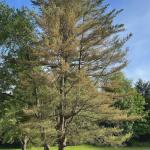
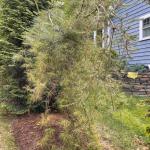
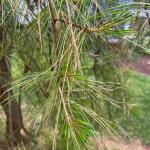 Pests/Problems: White pines continue to exhibit symptoms of needle blight, with yellowing/browning needles and premature shedding. New needles continue to expand but will not be fully developed for several weeks. As such, they are highly susceptible to infection at this time. Hard pines are also susceptible to many of the same fungal pathogens. Protecting these newly developing needles from becoming infected can be achieved with a variety of contact fungicides on smaller trees. Some anthracnose infections are starting to appear on oak, maple and beech, along with various other leaf spots and blotches. But overall, foliar disease severity appears to be low at this time. Rhododendrons with marginal leaf browning from winter injury should be pruned to remove all damaged leaves. If left, they can be colonized by a variety of foliar blight pathogens. Exobasidium gall of rhododendron and azalea can be found on certain plants. Prune and discard the distorted galls. Aphids and gall mites are distorting foliage or curling leaves on deciduous hardwoods. These insect pests cause only minor damage but are very conspicuous. Deciduous trees and shrubs, along with evergreens like rhododendron, may be exhibiting low levels of insect feeding. This can appear as scattered holes or notching along the margins. The culprits may not be harmful insects worthy of intervention and could be caused by native moth/butterfly larvae or leaf-cutter bees. Continue to regularly and closely inspect plants for symptoms and signs of insects and disease. If there are mounting insect infestations capable of significant damage, they can be missed without regular scouting.
Pests/Problems: White pines continue to exhibit symptoms of needle blight, with yellowing/browning needles and premature shedding. New needles continue to expand but will not be fully developed for several weeks. As such, they are highly susceptible to infection at this time. Hard pines are also susceptible to many of the same fungal pathogens. Protecting these newly developing needles from becoming infected can be achieved with a variety of contact fungicides on smaller trees. Some anthracnose infections are starting to appear on oak, maple and beech, along with various other leaf spots and blotches. But overall, foliar disease severity appears to be low at this time. Rhododendrons with marginal leaf browning from winter injury should be pruned to remove all damaged leaves. If left, they can be colonized by a variety of foliar blight pathogens. Exobasidium gall of rhododendron and azalea can be found on certain plants. Prune and discard the distorted galls. Aphids and gall mites are distorting foliage or curling leaves on deciduous hardwoods. These insect pests cause only minor damage but are very conspicuous. Deciduous trees and shrubs, along with evergreens like rhododendron, may be exhibiting low levels of insect feeding. This can appear as scattered holes or notching along the margins. The culprits may not be harmful insects worthy of intervention and could be caused by native moth/butterfly larvae or leaf-cutter bees. Continue to regularly and closely inspect plants for symptoms and signs of insects and disease. If there are mounting insect infestations capable of significant damage, they can be missed without regular scouting.
Berkshire Region (Great Barrington)
General Conditions: Very pleasant weather continued over the past week. It was neither very hot nor cold. Average daily temperatures for the monitoring week at the three Berkshire County National Weather Service monitoring sites were: 67ºF at North Adams, 63ºF at both Pittsfield and Richmond. It was quite comfortable. High/low temperatures at these sites were: 83ºF on 6/13 and 14 and a low of 49ºF on 6/11 at North Adams; 77ºF on 6/13 and a low of 47ºF on 6/11 at Pittsfield; 79ºF on 6/13 and a low of 45ºF on 6/11 in Richmond. Along with mostly sunny conditions and some persistent winds, the County could have drifted into the one of the drought categories designated by the U.S. Drought Monitor for Massachusetts. At this time Berkshire County, except for the eastern most edges of the central and southern areas, is not under drought conditions. The surface inch of soil has been dry at times but moisture below that has been adequate to prevent any wilting, except perhaps for newly planted specimens that were neglected. Every part of the County did receive at least an inch of rain on 6/9. Overall totals for the week were: 1.31 inches at North Adams, 1.69 inches at Pittsfield, 1.44 inches in Richmond, and 1.31 inches at West Stockbridge. Overall, the growth rate of plants has been normal for this time of year. Landscapes are lush.
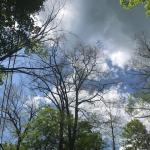
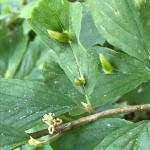
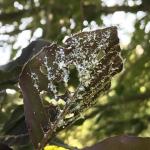 Pests/Problems: With just a few exceptions, pest and disease issues have not been of much concern. One exception is, of course, the spongy moth caterpillar or Lymantria dispar. The population of this defoliator varies from one part of the County to the next with the largest numbers and most severe defoliation in the southern areas and especially near the New York State border. The number of caterpillars and amount of defoliation rivals that of the 1979 outbreak. In just the past week, numerous trees have gone from partial defoliation to total defoliation. The caterpillars are so numerous that they can be seen crawling in mass numbers on the sides of buildings and just about any other surface. The range of plants on which they are found is far greater than this scout has ever seen. Not only are they feasting on the leaves of woody plants but also on many herbaceous plants. They are even climbing the stems of tall grasses, though not apparently eating the leaves. It appears that we are far from seeing the end of this plague and the damage caused since there are caterpillars at all instar stages. There is a long way to go. Other insects observed include: four-lined plant bug, leaf tiers, imported willow leaf beetle, and woolly beech aphid. Insect related galls observed include hickory stem and leaf galls and the cone gall aphid on witch hazel (Hamamelis sp.). Diseases have not been prominent except for a range of leaf spot diseases, e.g. apple scab and cedar apple rust, Phyllosticta leaf spot on Kousa dogwood (Cornus kousa), and leaf spots on maples. Weed growth has been rapid. Black-legged ticks remain abundant and tick bites are increasingly common. Given the risk of Lyme disease and, now, the occurrence of Powassan virus in several ticks recently tested in Massachusetts, it is more important than ever to take all precautions to protect oneself from ticks.
Pests/Problems: With just a few exceptions, pest and disease issues have not been of much concern. One exception is, of course, the spongy moth caterpillar or Lymantria dispar. The population of this defoliator varies from one part of the County to the next with the largest numbers and most severe defoliation in the southern areas and especially near the New York State border. The number of caterpillars and amount of defoliation rivals that of the 1979 outbreak. In just the past week, numerous trees have gone from partial defoliation to total defoliation. The caterpillars are so numerous that they can be seen crawling in mass numbers on the sides of buildings and just about any other surface. The range of plants on which they are found is far greater than this scout has ever seen. Not only are they feasting on the leaves of woody plants but also on many herbaceous plants. They are even climbing the stems of tall grasses, though not apparently eating the leaves. It appears that we are far from seeing the end of this plague and the damage caused since there are caterpillars at all instar stages. There is a long way to go. Other insects observed include: four-lined plant bug, leaf tiers, imported willow leaf beetle, and woolly beech aphid. Insect related galls observed include hickory stem and leaf galls and the cone gall aphid on witch hazel (Hamamelis sp.). Diseases have not been prominent except for a range of leaf spot diseases, e.g. apple scab and cedar apple rust, Phyllosticta leaf spot on Kousa dogwood (Cornus kousa), and leaf spots on maples. Weed growth has been rapid. Black-legged ticks remain abundant and tick bites are increasingly common. Given the risk of Lyme disease and, now, the occurrence of Powassan virus in several ticks recently tested in Massachusetts, it is more important than ever to take all precautions to protect oneself from ticks.
Regional Scouting Credits
- CAPE COD REGION - Russell Norton, Horticulture and Agriculture Educator with Cape Cod Cooperative Extension, reporting from Barnstable.
- SOUTHEAST REGION - Brian McMahon, Arborist, reporting from the Dighton area.
- NORTH SHORE REGION - Geoffrey Njue, Green Industry Specialist, UMass Extension, reporting from the Long Hill Reservation, Beverly.
- EAST REGION - Kit Ganshaw & Sue Pfeiffer, Horticulturists reporting from the Boston area.
- METRO WEST REGION – Julie Coop, Forester, Massachusetts Department of Conservation & Recreation, reporting from Acton.
- CENTRAL REGION - Mark Richardson, Director of Horticulture reporting from New England Botanic Garden at Tower Hill, Boylston.
- PIONEER VALLEY REGION - Nick Brazee, Plant Pathologist, UMass Extension Plant Diagnostic Lab, reporting from Amherst.
- BERKSHIRE REGION - Ron Kujawski, Horticultural Consultant, reporting from Great Barrington.
Woody Ornamentals
Diseases
Part II of the Eastern White Pine Management Institute Symposium will be held June 23rd and 24th in the Concord, NH area. Don't miss your chance to sign up and attend, as the deadline for registration is Friday, June 17th. The symposium will include speakers from North Carolina, Virginia, and New England discussing white pine management in their respective regions. We will also tour Durgin & Crowell Lumber Company’s pine mill and pellet facility and discuss management and health in the field. Sign up for both days or just one. More information can be found here:
Eastern White Pine Management Institute Symposium – Concord NH area. June 23 & 24, 2022. Registration deadline is June 17, 2022. June 23 - 6.0 Cat. 1 SAF CFEs and June 24 – 5.5 Cat. 1 SAF CFEs offered.
Recent pests and pathogens of interest seen in the UMass Extension Plant Diagnostic Lab, a select few:
- Beech leaf disease, caused by the foliar nematode Liltylenchus crenatae ssp. mccannii, of European beech (Fagus sylvatica). Trees spanning in age from ~10-years-old to >100-years-old. Symptoms range from dark banding and puckering on interveinal portions of the leaves, distorted and/or thickened and “leathery” leaves, bud abortion, and major canopy dieback. The disease is progressing at a much faster rate than what was reported from the Midwest. Initial reports from Ohio suggested that mature trees infested with the nematodes could suffer mortality after 10 years. However, reports from Bristol, Plymouth and Essex Counties show that trees are dying after only a few years of infection. Lower trunk drenching or soil drenching with mono- and di-potassium salts of Phosphorous acid should be performed in an attempt to save diseased trees. There are no other known treatments at this time.
- Dutch elm disease, caused by Ophiostoma novo-ulmi, of Princeton elm (Ulmus americana ‘Princeton’). The tree is 10-years-old and has been at the site for two years. It resides at a landscape site with full sun, deep loam soils, drip irrigation and no surrounding compaction. In early June, twig dieback developed and after pruning out the dead shoots, vascular staining was observed. After a short incubation of the symptomatic xylem tissue, asexual fruiting bodies (synemata) of O. novo-ulmi were observed. While Princeton elm is highly resistant to DED, it is not immune and mortality from DED occurs even when trees are provided with ideal conditions.
- Needle and stem blight of northern white-cedar (syn. Arborvitae; Thuja occidentalis), western red-cedar (T. plicata), and Green Giant arborvitae (T. plicata × standishii ‘Green Giant’) caused by Phyllosticta thujae. Numerous samples from a variety of different sites. Trees range in age from less than five-years-old to over 30-years-old. Most were planted as screening hedges with full sun but some are in shaded conditions. Many established hedges are not watered but once established, Thuja are fairly drought-resistant (although not as resistant as many people believe). Several of the trees were likely predisposed by winter injury, which seems to have been particularly severe on arborvitae this past winter. Typically, Phyllosticta can be found causing a tip blight but many of the samples have clear evidence of stem cankering caused by the pathogen. Pruning and removal of the dead needles and shoots is essential to reduce inoculum in these dense canopies. However, for established hedges the amount of pruning required can be a formidable task. Nevertheless, it must be done for proper disease management.
- Rhizosphaera needle cast of white spruce (Picea glauca) caused by Rhizosphaera kalkhoffii. The tree is believed to be approximately 90-years-old. It receives plentiful sun next to an old barn, but is surrounded by lawn. This spruce was receiving three fungicide treatments annually for needle cast disease from 2000 to 2019. Over this 20 year period, the appearance of the canopy slowly, but steadily, worsened and it was decided to end the fungicide treatments. The first two years post-treatment (2020 and 2021), the tree appeared more or less the same. However, over this past winter, the symptoms intensified dramatically with major needle loss and canopy thinning this spring. Rhizosphaera was the only pathogen detected on the submitted sample. This is an interesting case that suggests while the fungicide treatments were not stopping disease development, they were keeping disease progression advancing at a slow pace. Once treatment stopped, the disease intensified quickly to the point where the tree will now be removed.
- Brown rot of Kwanzan cherry (Prunus serrulata ‘Kwanzan’) caused by the fungal pathogen Monilinia. The tree is roughly 35-years-old and has been present at the site for at least 25 years. Around the beginning of June, a shoot tip blight developed in the canopy with browning and prematurely leaf shedding. The tree gets partial sun and some supplemental water from lawn sprinklers. Large, overstory oaks are all around the tree. Brown rot of stone fruits thrives in shaded, interior portions of the canopy, attacking succulent shoots, leaves and fruit. Ornamental cherries are somewhat susceptible, suffering from minor to moderate levels of disease. Plums and peaches are highly susceptible when site conditions are ideal.
Report by Nick Brazee, Plant Pathologist, UMass Extension Plant Diagnostic Lab, UMass Amherst.
Insects
An Update about Neonicotinoid Use in Massachusetts:
Beginning July 1, 2022 systemic insecticide active ingredients known as neonicotinoids will become state restricted use for tree and shrub uses in Massachusetts. If an individual works in the commercial industry (landscapers, arborists, etc.), then a Commercial Certification License is needed. (Example: Category 36 Commercial Certification License, Shade Trees & Ornamentals.) Someone can use a state or federal restricted use pesticide if they have a Commercial Applicators License as long as they are working under the direct supervision of someone with a Commercial Certification. Unlicensed or uncertified individuals will no longer be able to apply neonicotinoids to manage insect pests of trees and shrubs in Massachusetts.
More information is available, here: https://www.mass.gov/service-details/pesticide-newsupdates
Helpful Information from Taryn LaScola-Miner, Director, Crop and Pest Services Division of the MA Department of Agricultural Resources:
“As you know, products that contain neonicotinoids and have certain use patterns will have a classification change from General Use to Restricted Use on July 1, 2022. In order to help inform the manufacturers, dealers, sellers and applicators of which products will be changing from general use to restricted use, the Department has created the list of neonicotinoid products that currently are and will become restricted use beginning July 1st. You may find the list at the link below. Please note that this list is subject to change.
Additionally, MDAR is anticipating that there will be more of a need for companies to follow the Direct Supervision regulations with this change. Therefore, MDAR has updated its Direct Supervision Frequently Asked Questions document as well.
Although an email will be sent to all licensed applicators within the next few weeks as a final reminder of the change, please pass this information along to your members and customers as an effort to make this transition as smooth as possible. If you have any questions, please let me know. Thank you!”
List of Neonicotinoid Products: https://www.mass.gov/doc/list-of-neonicotinoid-pesticides/download
Direct Supervision Frequently Asked Questions: https://www.mass.gov/doc/direct-supervision-frequently-asked-questions-faq/download
Interesting Insects Reported Recently:
-
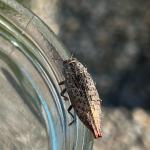
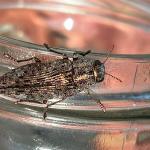
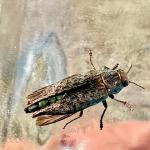 Dicerca spp. Jewel/Wood boring Beetles: Dicerca spp. are in the Family Buprestidae (jewel beetles, flatheaded borers). There are at least 24 species of jewel beetles in the genus Dicerca in North America, 16 of which are present in the northeast. The larvae of these insects have been reared from both conifers and deciduous trees, and the adults of nearly all but one of the species known to North America preferentially select damaged or dying trees to lay their eggs on. (The exception is D. pugionata, whose larvae feed on alder, witch hazel (Hamamelis virginiana), and common ninebark.) As such, these native insects should be preserved and do not require management. They are providing an ecosystem service by aiding in the decomposition of dead or dying plants. Two common species in this genus include Dicerca caudata whose larvae feed on alder and river birch, and D. divaricata whose larvae feed on maple, birch, redbud, ash, hophornbeam, oak, and elm. Finding these beetles is a sign that the tree or shrub has other primary stressors that are causing its decline.
Dicerca spp. Jewel/Wood boring Beetles: Dicerca spp. are in the Family Buprestidae (jewel beetles, flatheaded borers). There are at least 24 species of jewel beetles in the genus Dicerca in North America, 16 of which are present in the northeast. The larvae of these insects have been reared from both conifers and deciduous trees, and the adults of nearly all but one of the species known to North America preferentially select damaged or dying trees to lay their eggs on. (The exception is D. pugionata, whose larvae feed on alder, witch hazel (Hamamelis virginiana), and common ninebark.) As such, these native insects should be preserved and do not require management. They are providing an ecosystem service by aiding in the decomposition of dead or dying plants. Two common species in this genus include Dicerca caudata whose larvae feed on alder and river birch, and D. divaricata whose larvae feed on maple, birch, redbud, ash, hophornbeam, oak, and elm. Finding these beetles is a sign that the tree or shrub has other primary stressors that are causing its decline. -
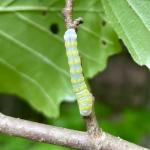
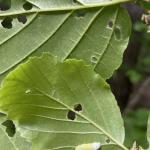
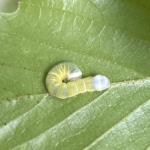 Eyed Mustard & Mustard Sallow Caterpillars: Three species of sallow caterpillar feed on witch hazel in eastern North America. Pyreferra citrombra (eyed mustard sallow), P. hesperidago (mustard sallow), and P. ceromatica. It is very difficult to distinguish between the caterpillars of these three species and Wagner (2005) calls for further study of this genus. Caterpillars may be found on witch hazel, hazel, and hophornbeam in woodlands and forests from Ontario to Georgia. One generation occurs annually with mature caterpillars in May and June. Adults are brown/tan and white winged moths. This genus belongs to the Family Noctuidae (owlet moths). These are native moth caterpillars that while noticeably active some years, are not typically considered pests. Lithophane querquera (shivering pinion) is a species with a caterpillar similar in appearance that is found on apple, ash, cherry, hickory, and oak. This species was noticed on witch hazel in Granville State Forest by Dr. Nick Brazee. His excellent photos are included here. Mustard sallow caterpillars were also reported in 2015 on witch hazel in the Berkshires. See report here: https://ag.umass.edu/landscape/landscape-message-jun-12-2015, which states:
Eyed Mustard & Mustard Sallow Caterpillars: Three species of sallow caterpillar feed on witch hazel in eastern North America. Pyreferra citrombra (eyed mustard sallow), P. hesperidago (mustard sallow), and P. ceromatica. It is very difficult to distinguish between the caterpillars of these three species and Wagner (2005) calls for further study of this genus. Caterpillars may be found on witch hazel, hazel, and hophornbeam in woodlands and forests from Ontario to Georgia. One generation occurs annually with mature caterpillars in May and June. Adults are brown/tan and white winged moths. This genus belongs to the Family Noctuidae (owlet moths). These are native moth caterpillars that while noticeably active some years, are not typically considered pests. Lithophane querquera (shivering pinion) is a species with a caterpillar similar in appearance that is found on apple, ash, cherry, hickory, and oak. This species was noticed on witch hazel in Granville State Forest by Dr. Nick Brazee. His excellent photos are included here. Mustard sallow caterpillars were also reported in 2015 on witch hazel in the Berkshires. See report here: https://ag.umass.edu/landscape/landscape-message-jun-12-2015, which states:
"A very colorful yellow and white striped caterpillar was found feeding on the foliage of witch hazel. The caterpillar was identified as belonging to the genus Pyreferra. Deb Swanson of Plymouth County believes the species to be Pyreferra hesperidago (mustard sallow caterpillar) which she has seen there in past years."
Insects and Other Arthropods
-
Deer Tick/Blacklegged Tick: Ixodes scapularis adults are active all winter and spring, as they typically are from October through May, and “quest” or search for hosts at any point when daytime temperatures are above freezing. Engorged females survive the winter and will lay 1,500+ eggs in the forest leaf litter beginning around Memorial Day (late May). Larval and nymphal deer ticks may be encountered at this time. Larvae are encountered in New England from roughly May through November, with peak risk reported in August. Nymphs are encountered from April through July with a peak risk reported in June in New England. Nymphs may also be encountered again in October and November. For images of all deer tick life stages, along with an outline of the diseases they carry, visit: https://web.uri.edu/tickencounter/species/blacklegged-tick/ .
Anyone working in the yard and garden should be aware that there is the potential to encounter deer ticks. The deer tick or blacklegged tick can transmit Lyme disease, human babesiosis, human anaplasmosis, and other diseases. Preventative activities, such as daily tick checks, wearing appropriate clothing, and permethrin treatments for clothing (according to label instructions) can aid in reducing the risk that a tick will become attached to your body. If a tick cannot attach and feed, it will not transmit disease. For more information about personal protective measures, visit: https://web.uri.edu/tickencounter/prevention/protect-yourself/
The Center for Agriculture, Food, and the Environment provides a list of potential tick identification and testing resources here: https://ag.umass.edu/resources/tick-testing-resources .
-
Mosquitoes: According to the Massachusetts Bureau of Infectious Disease and Laboratory Science and the Department of Public Health, there are at least 51 different species of mosquito found in Massachusetts. Mosquitoes belong to the Order Diptera (true flies) and the Family Culicidae (mosquitoes). As such, they undergo complete metamorphosis, and possess four major life stages: egg, larva, pupa, and adult. Adult mosquitoes are the only stage that flies and many female mosquitoes only live for 2 weeks (although the life cycle and timing will depend upon the species). Only female mosquitoes bite to take a blood meal, and this is so they can make eggs. Mosquitoes need water to lay their eggs in, so they are often found in wet or damp locations and around plants. Different species prefer different habitats. It is possible to be bitten by a mosquito at any time of the day, and again timing depends upon the species. Many are particularly active from just before dusk, through the night, and until dawn. Mosquito bites are not only itchy and annoying, but they can be associated with greater health risks. Certain mosquitoes vector pathogens that cause diseases such as West Nile virus (WNV) and eastern equine encephalitis (EEE).
For more information about mosquitoes in Massachusetts, visit: https://www.mass.gov/service-details/mosquitoes-in-massachusetts
There are ways to protect yourself against mosquitoes, including wearing long-sleeved shirts and long pants, keeping mosquitoes outside by using tight-fitting window and door screens, and using insect repellents as directed. Products containing the active ingredients DEET, permethrin, IR3535, picaridin, and oil of lemon eucalyptus provide protection against mosquitoes. Be aware that not all of these can be safely used on young children. Read and follow all label instructions for safety and proper use.
For more information about mosquito repellents, visit: https://www.mass.gov/service-details/mosquito-repellents and https://www.cdc.gov/mosquitoes/mosquito-bites/prevent-mosquito-bites.html
-
Wasps/Hornets: Many wasps are predators of other arthropods, including pest insects such as certain caterpillars that feed on trees and shrubs. Adult wasps hunt prey and bring it back to their nest where young are being reared, as food for the immature wasps. A common such example are the paper wasps (Polistes spp.) who rear their young on chewed up insects. They may be seen searching plants for caterpillars and other soft-bodied larvae to feed their young. Paper wasps can sting, and will defend their nests, which are open-celled paper nests that are not covered with a papery “envelope”. These open-celled nests may be seen hanging from eaves or other outdoor building structures. Aerial yellow jackets and hornets create large aerial nests that are covered with a papery shell or “envelope”. Common yellow jacket species include those in the genus Vespula. Dolichovespula maculata is commonly known as the baldfaced hornet, although it is not a true hornet. The European hornet (Vespa crabro) is three times the size of a yellow jacket and may be confused for the Asian giant hornet (Vespa mandarinia). The European hornet is known to Massachusetts, but the Asian giant hornet is not. If you are concerned that you have found or photographed an Asian giant hornet, please report it here: https://massnrc.org/pests/report.aspx . A helpful ID tool, although developed for Texas by the USDA, depicts common look-a-like species that we also have in MA that can be confused for the Asian giant hornet and is found here: https://agrilife.org/lubbock/files/2020/05/Asian_Giant_Hornet_Look-alikes_101_Xanthe_Shirley.pdf . Paper wasps and aerial yellowjackets overwinter as fertilized females (queens) and a single female produces a new nest annually in the late spring. Queens start new nests, lay eggs, and rear new wasps to assist in colony/nest development. Nests are abandoned at the end of the season. Some people are allergic to stinging insects, so care should be taken around wasp/hornet nests. Unlike the European honeybee (Apis mellifera), wasps and hornets do not have barbed stingers, and therefore can sting repeatedly when defending their nests. It is best to avoid them, and if that cannot be done and assistance is needed to remove them, consult a professional.
Woody ornamental insect and non-insect arthropod pests to consider, a selected few:
Invasive Insects & Other Organisms Update:
-
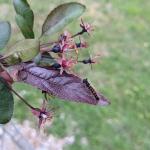 Spongy Moth: Lymantria dispar egg hatch was first reported to UMass Extension by arborists in Great Barrington, MA in early May, and activity has intensified since that time. Professionals and property owners working and living in Berkshire County continue to be on high alert as they monitor and manage spongy moth caterpillar feeding. At this time, the caterpillars are being found in all instar sizes and complete defoliation is occuring in the most infested areas in western MA. Defoliation will continue as all the caterpillars continue to grow. (See Berkshire Region report above for additional information.)
Spongy Moth: Lymantria dispar egg hatch was first reported to UMass Extension by arborists in Great Barrington, MA in early May, and activity has intensified since that time. Professionals and property owners working and living in Berkshire County continue to be on high alert as they monitor and manage spongy moth caterpillar feeding. At this time, the caterpillars are being found in all instar sizes and complete defoliation is occuring in the most infested areas in western MA. Defoliation will continue as all the caterpillars continue to grow. (See Berkshire Region report above for additional information.)
If high-value specimen trees in Berkshire County are currently being defoliated by young spongy moth caterpillars, consider applying the reduced risk insecticide Bacillus thuringiensis Kurstaki (Btk) to host plant leaves if caterpillars are still small and actively feeding, but before caterpillars are over ¾ inch in length. Spinosad is an additional reduced risk active ingredient for the management of spongy moth caterpillars. Unfortunately, however, it is likely too late for such treatments. Once spongy moth caterpillars are large (2-3 inches in length) and very noticeable, they are very difficult to manage and will have already done much of their feeding. It is preferable to treat the early instar caterpillars, if chemical management is deemed necessary on ornamental plants in the landscape. Keep in mind that most healthy trees can survive a single year of defoliation, if they do not have other stressors. Specimen trees that were defoliated last year in Berkshire County, that have caterpillars feeding on them again this year, should be prioritized.
Why did the common name for Lymantria dispar change recently? More information is available here: https://entsoc.org/news/press-releases/spongy-moth-approved-new-common-name-lymantria-dispar
To learn more about the life cycle and natural enemies of this insect, visit: https://ag.umass.edu/landscape/education-events/insectxaminer
-
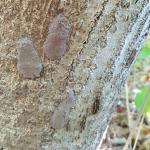 Spotted Lanternfly: (Lycorma delicatula, SLF) is a non-native, invasive insect that feeds on over 103 species of plants, including many trees and shrubs that are important in our landscapes.
Spotted Lanternfly: (Lycorma delicatula, SLF) is a non-native, invasive insect that feeds on over 103 species of plants, including many trees and shrubs that are important in our landscapes.
The MA Department of Agricultural Resources (MDAR) recently published the following press release, urging professionals and the general public to search all nursery stock, particularly maples and crabapples, purchased this year for spotted lanternfly egg masses: https://www.mass.gov/news/state-agricultural-officials-ask-public-to-be-on-alert-for-hatching-of-invasive-spotted-lanternfly-eggs . In particular, the press release warns:
“MDAR recently received reports that nursery stock from SLF-infested areas may have been sent to Massachusetts growers. Due to this, anyone who has recently purchased trees or shrubs or had them planted on their property, particularly maple or crabapple trees, is being asked to inspect the trunk and branches to ensure there are no SLF egg masses or any hitchhiking nymphs, and to report any finds to MDAR. Landscapers and plant nurseries are also being reminded to stay on the lookout for this pest.”
Currently, the only established populations of spotted lanternfly in Massachusetts are in a small area in both Fitchburg and Shrewsbury, MA. Therefore, there is no reason to be preemptively treating for this insect in other areas of Massachusetts. If you suspect you have found spotted lanternfly in additional locations, please report it immediately to MDAR here: https://massnrc.org/pests/slfreport.aspx . If you are living and working in the Fitchburg and Shrewsbury areas, please be vigilant and continue to report anything suspicious.
For More Information:
From UMass Extension:
Check out the InsectXaminer Episode about spotted lanternfly adults and egg masses! Available here: https://ag.umass.edu/landscape/education-events/insectxaminer
Fact Sheet: https://ag.umass.edu/landscape/fact-sheets/spotted-lanternfly
From the MA Department of Agricultural Resources:
Fact Sheet and Map of Locations in MA: https://massnrc.org/pests/pestFAQsheets/spottedlanternfly.html
-
Asian Longhorned Beetle: (Anoplophora glabripennis, ALB) Look for signs of an ALB infestation which include perfectly round exit holes (about the size of a dime), shallow oval or round scars in the bark where a female has chewed an egg site, or sawdust-like frass (excrement) on the ground nearby host trees or caught in between branches. Be advised that other, native insects may create perfectly round exit holes or sawdust-like frass, which can be confused with signs of ALB activity.
The regulated area for Asian longhorned beetle is 110 square miles encompassing Worcester, Shrewsbury, Boylston, West Boylston, and parts of Holden and Auburn. If you believe you have seen damage caused by this insect, such as exit holes or egg sites, on susceptible host trees like maple, please call the Asian Longhorned Beetle Eradication Program office in Worcester, MA at 508-852-8090 or toll free at 1-866-702-9938.
To report an Asian longhorned beetle find online or compare it to common insect look-alikes, visit: http://massnrc.org/pests/albreport.aspx or https://www.aphis.usda.gov/pests-diseases/alb/report .
-
Browntail Moth: Euproctis chrysorrhoea is an invasive insect originating from Europe and first detected in the US in Somerville, MA in 1897. Currently, browntail moth is limited to a small portion of eastern Massachusetts, particularly areas near the coast. Report suspected browntail moth life stages here: https://massnrc.org/pests/pestreports.htm . Due to a persistent outbreak of this insect in Maine since approximately 2016, it is a good idea for us to again familiarize ourselves with this pest. (For more information and the latest updates about the status of this insect in Maine, visit: https://www.maine.gov/dacf/mfs/forest_health/invasive_threats/browntail_moth_info.htm .)
Caution: hairs found on the caterpillar and pupal life stages of this insect can cause a rash similar to poison ivy. Some individuals are very sensitive to browntail moth hairs and may also experience allergic reaction. The chance of interacting with browntail moth hairs increases between May and July, although they could be a problem at any time of year.
The larval or caterpillar stage of this insect is present from August until the following June (spending the winter in webs they create on the tips of host plant twigs). In the fall, groups of caterpillars are found creating webs around a tightly wrapped leaf (covered in bright white silk) where they will overwinter in groups of 25-400. These 2-4 inch long webs can be found on the ends of branches often on apple or red oak. As soon as leaves begin to open in the spring (usually by April), the caterpillars will crawl from their webs to feed on the new leaves. Caterpillars are fully grown around June and spin cocoons in which they pupate. These cocoons are also full of the irritating hairs and should be dealt with extreme caution. Adult moths emerge in July and females lay eggs on the undersides of leaves in masses of 200-400, covering them with hairs from their bodies. (Adults do not typically cause skin rashes.) Eggs hatch around August and September and larvae feed shortly before forming their overwintering webs.
The primary concern with this insect are the poisonous hairs found on the caterpillars. Contact with the caterpillar or its hairs can cause a rash similar to poison ivy in susceptible individuals. If hairs break off and blow around in the wind, they can cause difficulty breathing and headaches. While this insect can act as a defoliator in the larval stage, feeding on the leaves of many deciduous trees and shrubs, this activity may be secondary to concerns about public health risks. Care should be taken to avoid places infested with these caterpillars, exposed skin or clothing should be washed, and the appropriate PPE should be worn if working with these insects. Consult your physician if you have a reaction to the browntail moth.
-
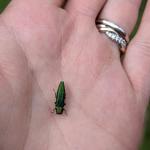 Emerald Ash Borer: (Agrilus planipennis, EAB) has been detected in at least 11 out of the 14 counties in Massachusetts. A map of these locations across the state may be found here: https://ag.umass.edu/fact-sheets/emerald-ash-borer . Additional information about this insect is provided by the MA Department of Conservation and Recreation, here:https://arcg.is/j8TiD .
Emerald Ash Borer: (Agrilus planipennis, EAB) has been detected in at least 11 out of the 14 counties in Massachusetts. A map of these locations across the state may be found here: https://ag.umass.edu/fact-sheets/emerald-ash-borer . Additional information about this insect is provided by the MA Department of Conservation and Recreation, here:https://arcg.is/j8TiD .
This wood-boring beetle readily attacks ash (Fraxinus spp.) including white, green, and black ash and has also been found developing in white fringe tree (Chionanthus virginicus) and has been reported in cultivated olive (Olea europaea). Signs of an EAB infested tree may include D-shaped exit holes in the bark (from adult emergence), “blonding” or lighter coloration of the ash bark from woodpecker feeding (chipping away of the bark as they search for larvae beneath), and serpentine galleries visible through splits in the bark, from larval feeding beneath. It is interesting to note that woodpeckers are capable of eating 30-95% of the emerald ash borer larvae found in a single tree (Murphy et al. 2018). Unfortunately, despite high predation rates, EAB populations continue to grow. However, there is hope that biological control efforts will eventually catch up with the emerald ash borer population and preserve some of our native ash tree species for the future. For an update about the progress of the biological control of emerald ash borer, visit Dr. Joseph Elkinton’s archived 2022 webinar.
-
Jumping Worms: Amynthas spp. earthworms, collectively referred to as “jumping or crazy or snake” worms, overwinter as eggs in tiny, mustard-seed sized cocoons found in the soil or other substrate (ex. compost) that are impossible to remove. The first adults appear in the end of May – June, but the numbers are low and infestations are rarely noticed at that time. It is easy to misidentify earthworms if only immatures found. By August and September, this is when most observations of fully mature jumping worms occur. At that time, snake worms become quite abundant, infestations become very noticeable, and may cause a lot of concern for property owners and managers.
For More Information:
UMass Extension Fact Sheets:
Earthworms in Massachusetts – History, Concerns, and Benefits: https://ag.umass.edu/landscape/fact-sheets/earthworms-in-massachusetts-history-concerns-benefits
Jumping/Crazy/Snake Worms – Amynthas spp.:
https://ag.umass.edu/landscape/fact-sheets/jumpingcrazysnake-worms-amynthas-spp
A Summary of the Information Shared at UMass Extension’s Jumping Worm Conference in January 2022:
https://ag.umass.edu/news-events/highlights/jumping-worms-conference
Tree & Shrub Insect Pests, Continued:
-
Arborvitae Leafminer: In New England and eastern Canada, four species of leafminers are known to infest arborvitae. These include Argyresthia thuiella, A. freyella, A. aureoargentella, and Coleotechnites thujaella. The arborvitae leafminer, A. thuiella, is the most abundant of these and has the greatest known range when compared to the others. (It is also found in the Mid-Atlantic States and as far west as Missouri). Moths of this species appear from mid-June to mid-July and lay their eggs. The damage caused by all of these species is nearly identical. Trees, however, have been reported to lose up to 80% of their foliage due to arborvitae leafminer and still survive. At least 27 species of parasites have been reported as natural enemies of arborvitae leafminers, the most significant of which may be a parasitic wasp (Pentacnemus bucculatricis). Arborvitae leafminer damage causes the tips of shoots and foliage to turn yellow and brown. If infestations are light, prune out infested tips.
-
Azalea Sawflies: There are a few species of sawflies that impact azaleas. Johnson and Lyon's Insects that Feed on Trees and Shrubs mentions three of them. Amauronematus azaleae was first reported in New Hampshire in 1895 and is likely found in most of New England. Adults of this species are black with some white markings and wasp-like. Generally green larvae feed mostly on mollis hybrid azaleas. Remember, sawfly caterpillars have at least enough abdominal prolegs to spell “sawfly” (so 6 or more prolegs). Adults are present in May, and females lay their eggs and then larvae hatch and feed through the end of June. There is one generation per year. Nematus lipovskyi has been reared from swamp azalea (Rhododendron viscosum). Adults of that species have been collected in April (in states to the south) and May (in New England) and larval feeding is predominantly in late April and May in Virginia and June in New England. One generation of this species occurs per year, and most mollis hybrid azaleas can be impacted. A third species, Arge clavicornis, is found as an adult in July and lays its eggs in leaf edges in rows. Larvae are present in August and September. Remember, Bacillus thuringiensis Kurstaki does not manage sawflies.
-
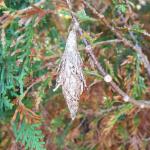 Bagworm: Thyridopteryx ephemeraeformis is a native species of moth whose larvae construct bag-like coverings over themselves with host plant leaves and twigs. This insect overwinters in the egg stage, within the bags of deceased females from last season. Eggs may hatch and young larvae are observed feeding around mid-June, or roughly between 600-900 GDD’s. Now is the time to scout for and remove and destroy overwintering bags. More information can be found here: https://ag.umass.edu/landscape/fact-sheets/bagworm
Bagworm: Thyridopteryx ephemeraeformis is a native species of moth whose larvae construct bag-like coverings over themselves with host plant leaves and twigs. This insect overwinters in the egg stage, within the bags of deceased females from last season. Eggs may hatch and young larvae are observed feeding around mid-June, or roughly between 600-900 GDD’s. Now is the time to scout for and remove and destroy overwintering bags. More information can be found here: https://ag.umass.edu/landscape/fact-sheets/bagworm
-
Boxwood Leafminer: Monarthropalpus flavus partly grown fly larvae overwinter in the leaves of susceptible boxwood. Yellowish mines may be noticeable on the undersides of leaves. This insect grows rapidly in the spring, transforming into an orange-colored pupa. After pupation, adults will emerge and white colored pupal cases may hang down from the underside of leaves where adults have emerged. Adults may be observed swarming hosts between 300-650 GDD’s, or roughly the end of May through June. Most cultivars of Buxus sempervirens and B. microphylla are thought to be susceptible. If installing new boxwoods, resistant cultivars such as ‘Vardar Valley’ and ‘Handsworthiensis’ are good choices at sites where this insect has been a problem.
-
Boxwood Mite: Eurytetranychus buxi overwinter as tiny eggs on boxwood leaves and hatch mid-spring. These mites are tiny (about the size of a period) and difficult to detect. Feeding may cause plants to appear off-color. If management is deemed necessary, the timing for treatment may be between 245-600 GDD’s.
-
Boxwood Psyllid: Psylla buxi feeding can cause cupping of susceptible boxwood leaves. Leaf symptoms/damage may remain on plants for up to two years. English boxwood may be less severely impacted by this pest. While foliar applications may be made between 290-440 GDD’s, the damage caused by this insect is mostly aesthetic. Therefore, typically, management is not necessary.
-
Dogwood Borer: Synanthedon scitula is a species of clearwing moth whose larvae bore not only into dogwood (Cornus), but hosts also include flowering cherry, chestnut, apple, mountain ash, hickory, pecan, willow, birch, bayberry, oak, hazel, myrtle, and others. Kousa dogwood appear to be resistant to this species. Signs include the sloughing of loose bark, brown frass, particularly near bark cracks and wounds, dead branches, and adventitious growth. The timing of adult emergence can be expected when dogwood flower petals are dropping and weigela begins to bloom. Adult moth flights continue from then until September. Emergence in some hosts (ex. apple) appears to be delayed, but this differs depending upon the location in this insect’s range. Eggs are laid singly, or in small groups, on smooth and rough bark. Female moths preferentially lay eggs near wounded bark. After hatch, larvae wander until they find a suitable entrance point into the bark. This includes wounds, scars, or branch crotches. This insect may also be found in twig galls caused by other insects or fungi. Larvae feed on phloem and cambium. Fully grown larvae are white with a light brown head and are approx. ½ inch long. Pheromone traps and lures are useful for determining the timing of adult moth emergence and subsequent management.
-
Dogwood Sawfly: Macremphytus tarsatus has one generation per year. The larvae of the dogwood sawfly overwinter in decaying wood and occasionally compromised structural timber. An overwintering "cell" is created in this soft wood. Pupation occurs in the springtime and adults can take a lengthy time to emerge, roughly between late May and July. 100+ eggs are laid in groups on the underside of leaves. Eggs hatch and the larvae feed gregariously, initially skeletonizing leaves. As the caterpillars grow in size, they are capable of eating the entire leaf with the exception of the midvein. Larval appearance varies greatly throughout instars, so much so that one might mistake them for multiple species. Early instars are translucent and yellow, but as the caterpillars grow they develop black spots (over yellow) and become covered in a white powder-like material. Larvae and their shed skins may resemble bird droppings. Full grown larvae begin to wander in search of a suitable overwintering location. Rotting wood lying on the ground is preferred for this. Foliage of dogwood, especially gray dogwood (Cornus racemosa) may be impacted. Skeletonizes leaves at first, then eats all but the midvein.
-
Eastern Tent Caterpillar: Malacosoma americanum eggs overwinter on host plant twigs. Egg hatch typically occurs when wild cherry leaves begin to unfold and young caterpillars may emerge by late-April through the first two weeks in May (90-190 GDD’s). Susceptible hosts include cherry and crabapple. Other host plants whose leaves are fed upon by this native insect can include apple, ash, birch, willow, maple, oak, poplar, and witch-hazel. Where practical, prune out and remove new eastern tent caterpillar tents before they become larger as the caterpillars continue to feed. Eastern tent caterpillars are large and beginning to wander from their nests in parts of Hampshire County, MA as of 5/30/2022. Eastern tent caterpillars are native to Massachusetts and have many associated natural enemies (parasites and predators) that help regulate populations. Unless these caterpillars are actively defoliating specimen trees in a landscaped setting, we can coexist with this particular herbivore native to our forests.
-
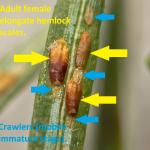 Elongate Hemlock Scale: Fiorinia externa is found on eastern, Carolina, and Japanese hemlock, as well as yew, spruce, and fir. The elongate hemlock scale may overwinter in various life stages and overlap of many developmental stages at any given time can be observed throughout much of the season. Treatments for the crawler, or mobile, stage of this insect may be made in late May through mid-June, or between 360-700 GDD’s, base 50°F. Nitrogen fertilizer applications may make elongate hemlock scale infestations worse.
Elongate Hemlock Scale: Fiorinia externa is found on eastern, Carolina, and Japanese hemlock, as well as yew, spruce, and fir. The elongate hemlock scale may overwinter in various life stages and overlap of many developmental stages at any given time can be observed throughout much of the season. Treatments for the crawler, or mobile, stage of this insect may be made in late May through mid-June, or between 360-700 GDD’s, base 50°F. Nitrogen fertilizer applications may make elongate hemlock scale infestations worse.
- Euonymus Caterpillar: Yponomeuta cagnagella is of European origin and widespread in distribution throughout Europe. It was first reported in North America in Ontario in 1967. The euonymus caterpillars (larvae) feed in groups and envelop the foliage of the host plant in webs as they feed. Hosts include: Euonymus europaeus (tree form), E. kiautschovicus, E. alatus, and E. japonicus. Mature caterpillars are just under an inch in length, creamy yellow-gray in color with black spots and a black head capsule. By late June, these larvae pupate in white, oval-shaped cocoons which are typically oriented together vertically either on host plants or non-hosts in the area. Cocoons can be found in cracks and crevices, or webbed together leaves. The adult moth emerges in late June in most locations. The adult female secretes a gummy substance over her eggs which will harden, making them even more difficult to see. Eggs hatch by mid-August, at which time the tiny larvae prepare to overwinter beneath their eggshell-like covering. These larvae are inactive until the following year, when caterpillars group together to feed on newly emerging leaves, creating a mess of webs as they feed. There is one generation per year. Plants may be partially or entirely defoliated. Management of young, actively feeding caterpillars with Bacillus thuringiensis is possible if deemed necessary, however many species of Euonymus are considered invasive themselves.
Check out Episode 3 of InsectXaminer to see the euonymus caterpillar in action and learn more about its life cycle: https://ag.umass.edu/landscape/education-events/insectxaminer
- Euonymus Scale: Unaspis euonymi is an armored scale that can be found on euonymus, holly, bittersweet, and pachysandra. This insect can cause yellow spotting on leaves, dieback, and distorted bark. For crawlers, early June timing is suggested between 533-820 GDD’s. (Eggs begin to hatch in early June.)
- European Elm Scale: Gossyparia spuria is a type of felt scale. First noted in New York in 1884, this non-native scale is now widespread in North America and is found on native and European elms, but also rarely on hackberry and Zelkova. This insect can cause yellowing of foliage, premature leaf drop, and eventually dieback on its host. Honeydew and thus sooty mold are produced. By the end of June, females will lay eggs that hatch into bright yellow crawlers, which will disperse to the midrib and leaf veins on the underside of elm leaves where they will remain to feed. Crawlers are tiny and magnification is necessary to observe. Natural enemies such as parasitic wasps and predatory insects have been reported as successful in managing this insect.
-
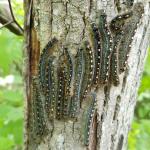 Forest Tent Caterpillar: Malacosoma disstria egg hatch occurs between 192-363 GDD’s, base 50°F, by mid-late May and caterpillars may be active for at least 5-6 weeks following. Susceptible hosts whose leaves are fed on by this insect include oak, birch, ash, maple, elm, poplar, and basswood. This native insect has many natural enemies, including some very effective pathogens that typically regulate populations. However, outbreaks of this insect can occur on occasion.
Forest Tent Caterpillar: Malacosoma disstria egg hatch occurs between 192-363 GDD’s, base 50°F, by mid-late May and caterpillars may be active for at least 5-6 weeks following. Susceptible hosts whose leaves are fed on by this insect include oak, birch, ash, maple, elm, poplar, and basswood. This native insect has many natural enemies, including some very effective pathogens that typically regulate populations. However, outbreaks of this insect can occur on occasion.
- Hemlock Borer: Phaenops (Melanophila) fulvoguttata is in the Family Buprestidae (jewel beetles, flatheaded borers). The hemlock borer belongs to the genus Phaenops whose northeastern species are different enough that they can be relatively easily separated by their coloration and pronotal and elytral sculpturing. As such, it is easier to identify adult beetles by photograph (without observing a specimen with a dissecting microscope and looking at specific features with a dichotomous key). 15
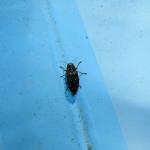 species are known to this genus in North America, and five of those have been recorded in the northeast. Coniferous hosts are the only known larval hosts for this genus, and in the case of P. fulvoguttata, the larvae have been recorded from balsam fir, American larch, white spruce, black spruce, red spruce, eastern white pine, and eastern hemlock. The hemlock borer is considered “infrequently collected”. This native species is likely a secondary pest or decomposer, and not the primary cause of decline in its hosts.
species are known to this genus in North America, and five of those have been recorded in the northeast. Coniferous hosts are the only known larval hosts for this genus, and in the case of P. fulvoguttata, the larvae have been recorded from balsam fir, American larch, white spruce, black spruce, red spruce, eastern white pine, and eastern hemlock. The hemlock borer is considered “infrequently collected”. This native species is likely a secondary pest or decomposer, and not the primary cause of decline in its hosts. -
Hemlock Looper: Two species of geometrid moths in the genus Lambdina are native insects capable of defoliating eastern hemlock, balsam fir, and white spruce. Adult moths lay their eggs on the trunk and limbs of hosts in September and October, and eggs will hatch by late May or early June. (L. fiscellaria caterpillars may be active between 448-707 GDD’s.) Monitor susceptible hosts for small, inch-worm like caterpillars. Where populations are low, no management is necessary. Hemlock loopers have several effective natural enemies.
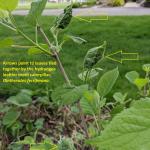
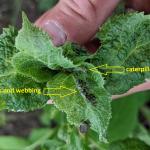 Hydrangea Leaftier: Olethreutes ferriferana is a moth in the Family Tortricidae whose caterpillars use silk applied to the edges of two newly expanding hydrangea leaves to tie them together to create an envelope-like structure within which they feed. These leaf-envelopes tend to occur near the tips of plant stems and can be very obvious. As a result, the two tied leaves may not fully expand when compared to healthy, non-impacted leaves. Hydrangea leaftier activity was seen on 5/15/2022 in Pittsfield, MA. Many envelope or purse-like structures were seen throughout the plants and could be found from the base to the top of the plant. By gently pulling apart the tied-together leaves, tiny caterpillars were revealed within and able to be mechanically managed by crushing the individual caterpillars.
Hydrangea Leaftier: Olethreutes ferriferana is a moth in the Family Tortricidae whose caterpillars use silk applied to the edges of two newly expanding hydrangea leaves to tie them together to create an envelope-like structure within which they feed. These leaf-envelopes tend to occur near the tips of plant stems and can be very obvious. As a result, the two tied leaves may not fully expand when compared to healthy, non-impacted leaves. Hydrangea leaftier activity was seen on 5/15/2022 in Pittsfield, MA. Many envelope or purse-like structures were seen throughout the plants and could be found from the base to the top of the plant. By gently pulling apart the tied-together leaves, tiny caterpillars were revealed within and able to be mechanically managed by crushing the individual caterpillars.
Caterpillars are green and partially transparent with a black head capsule and a black thoracic shield which is found on the top of the body segment located directly behind the head. Pupation is thought to occur in the ground nearby host plants, so the insect drops to the ground to pupate where it overwinters. Pupation occurs sometime in June. Adults are found in the spring and are small white and brown moths. Eggs are laid on branch tips of various species of hydrangea. Only one generation is known per year. This insect, although creating visible and interesting damage to hydrangea, is not usually considered to be a serious pest – although occasional localized problematic populations have been reported. Removing leaf-envelopes in the early spring or pinching them to kill the caterpillar within can help reduce populations on individual plants.
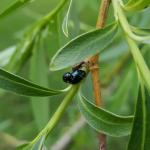 Imported Willow Leaf Beetle: Plagiodera versicolora adult beetles overwinter near susceptible hosts. Adult beetles will chew holes and notches in the leaves of willow once they become available. Females lay yellow eggs in clusters on the undersides of leaves. Larvae are slug-like and bluish-green in color. They will feed in clusters and skeletonize the leaves. Most plants can tolerate multiple years of feeding from this insect, and foliage will appear brown. Repeated yearly feeding can occasionally be an issue, in which case management of the young larvae may be necessary. Take care with treatment in areas near water.
Imported Willow Leaf Beetle: Plagiodera versicolora adult beetles overwinter near susceptible hosts. Adult beetles will chew holes and notches in the leaves of willow once they become available. Females lay yellow eggs in clusters on the undersides of leaves. Larvae are slug-like and bluish-green in color. They will feed in clusters and skeletonize the leaves. Most plants can tolerate multiple years of feeding from this insect, and foliage will appear brown. Repeated yearly feeding can occasionally be an issue, in which case management of the young larvae may be necessary. Take care with treatment in areas near water.
Check out Episode 4 of InsectXaminer to see the imported willow leaf beetle in action: https://ag.umass.edu/landscape/education-events/insectxaminer
- Lacebugs: Stephanitis spp. lacebugs such as S. pyriodes can cause severe injury to azalea foliage. S. rhododendri can be common on rhododendron and mountain laurel. S. takeyai has been found developing on Japanese andromeda, leucothoe, styrax, and willow. Stephanitis spp. lace bug activity should be monitored through September. Before populations become too large, treat with a summer rate horticultural oil spray as needed. Be sure to target the undersides of the foliage in order to get proper coverage of the insects. Certain azalea and andromeda cultivars may be less preferred by lace bugs.
-
Lecanium Scales (Oak): Parthenolecanium quercifex overwinters as a second instar nymph on oak twigs. Females will begin feeding and mature in the spring, from mid-April to early May and eggs may be laid between late May and into June. Eggs hatch in June or early July and crawlers migrate to host plant leaves where they spend the summer and migrate as second instars back to host plant twigs in the fall.
-
Lilac Borer: Podosesia syringae is a clearwing moth pest of lilac, privet, fringetree, and ash. (It is also known as the ash borer, not to be confused with the emerald ash borer.) Adults mimic paper wasps. Larvae are wood-boring, and signs and symptoms include branch dieback, holes, and occasionally, sawdust-like frass accumulated on bark. Larvae bore into stems, trunks, and branches, chewing an irregularly shaped entrance hole. Peak adult moth flights may occur in the northern portion of this insect’s range in June and are usually over by August 1st. Pheromone traps can be used to time adult emergence. Adult females lay flattened, oval, and tan eggs that are deposited singly or in clusters on bark crevices, ridges, and sometimes smooth bark; but usually laid in or near wounds in the bark. On average, 395 eggs are laid by each female. After hatch, larvae chew into the bark and feed laterally and then vertically in phloem tissue. Larvae overwinter in tunnels in the final instar and resume feeding in the spring. Adults emerge through a round exit hole (4-5 mm. in diameter). This insect may be targeted between 200-299 GDD’s, base 50°F.
-
Magnolia Scale: Neolecanium cornuparvum overwinters as first instar nymphs which are elliptical, and dark slate gray in color and can usually be found on the undersides of 1 and 2 year old twigs. Nymphs may molt by late April or May and again by early June at which time the scales may be purple in color. Eventually nymphs secrete a white powdery layer of wax over their bodies.
- Rhododendron Borer: Synanthedon rhododendri is one of the smallest of the native clearwing moths. Rhododendrons are preferred hosts, although mountain laurel, and deciduous azaleas can be heavily infested, especially if they are planted in close proximity to rhododendrons. Injury may be first noticed in the fall (leaves lose their sheen, then become pale green, then olive, then chlorotic) and can look similar to drought stress. On branches that seem to be stunted, look at limb crotches, scars, and other irregularities for sawdust stuck on bark or on the ground beneath these areas. In late May and early June, holes may contain pupal shed skins extending halfway out. Moth emergence occurs in the late-spring, early-summer. After mating, female moths seek out suitable egg laying locations (preferring wounded areas or limb crotches). The female lays her eggs and dies. Eggs hatch and larvae tunnel into the inner bark where they feed in tunnels that become packed with reddish frass pellets. By late fall, larvae move to the sapwood where they overwinter and resume feeding by mid-March. Pupation occurs in the spring and there is one generation per year. Prune out and destroy infested branches before late May/June.
- Roseslugs: Two species of sawfly can be found on the leaves of roses at this time. These small, caterpillar-like larvae will skeletonize the upper leaf surface and leave a “window-pane” like pattern behind. When present in large numbers, these insects are capable of defoliating their entire host. Caterpillars may feed until roughly mid-June, at which time they will pupate. Management options include an insecticidal soap spray or a product containing spinosad.
-
Spruce Spider Mite: Oligonychus ununguis is a cool-season mite that becomes active in the spring from tiny eggs that have overwintered on host plants. Hosts include spruce, arborvitae, juniper, hemlock, pine, Douglas-fir, and occasionally other conifers. This particular species becomes active in the spring and can feed, develop, and reproduce through roughly June. When hot, dry summer conditions begin, this spider mite will enter a summer-time dormant period (aestivation) until cooler temperatures return in the fall. This particular mite may prefer older needles to newer ones for food. Magnification is required to view spruce spider mite eggs. Tapping host plant branches over white paper may be a useful tool when scouting for spider mite presence. (View with a hand lens.) Spider mite damage may appear on host plant needles as yellow stippling and occasionally fine silk webbing is visible. Be sure to also scout for predatory mite adults and eggs which can help regulate spruce spider mite populations. Avoid broad spectrum chemical management options that kill predatory mite populations, often making spruce spider mite outbreaks worse.
-
Taxus Mealybug: Dysmicoccus wistariae will produce honeydew and lead to sooty mold growth, yellowing of needles, and sparsely foliated plants. Eventual dieback may be possible. This species is commonly associated with taxus in New England, but can be occasionally found on dogwood, rhododendron, Prunus spp., maple, andromeda, and crabapple. These mealybugs are found on stems and branches and particularly like to congregate at branch crotches. Taxus mealybug feeds in the inner bark tissue of the trunk and branches. Adult females are present from June to August and give birth to living young in the summer. Immatures overwinter. A single generation may occur per year in New England, but areas to the south can have multiple generations of this insect. Management may be targeted between 246-618 GDD’s, base 50°F. Horticultural oil and neem oil may be used.
-
Viburnum Leaf Beetle: Pyrrhalta viburni is a beetle in the family Chrysomelidae that is native to Europe, but was found in Massachusetts in 2004. This beetle feeds exclusively on many different species of viburnum, which includes, but is not limited to, susceptible plants such as V. dentatum, V. nudum, V. opulus, V. propinquum, and V. rafinesquianum. Some viburnum have been observed to have varying levels of resistance to this insect, including but not limited to V. bodnantense, V. carlesii, V. davidii, V. plicatum, V. rhytidophyllum, V. setigerum, and V. sieboldii. More information about viburnum leaf beetle may be found at http://www.hort.cornell.edu/vlb/ .
-
White Spotted Pine Sawyer (WSPS): Monochamus scutellatus adults can emerge in late May throughout July, depending on local temperatures. This is a native insect in Massachusetts and is usually not a pest. Larvae develop in weakened or recently dead conifers, particularly eastern white pine (Pinus strobus). However, the white spotted pine sawyer looks very similar to the invasive Asian Longhorned Beetle, Anoplophora glabripennis, ALB. ALB adults do not emerge in Massachusetts until July and August. Beginning in July, look for the key difference between WSPS and ALB adults, which is a white spot in the top center of the wing covers (the scutellum) on the back of the beetle. White spotted pine sawyer will have this white spot, whereas Asian longhorned beetle will not. Both insects can have other white spots on the rest of their wing covers; however, the difference in the color of the scutellum is a key characteristic. See the Asian longhorned beetle entry above for more information about that non-native insect.
Concerned that you may have found an invasive insect or suspicious damage caused by one? Need to report a pest sighting? If so, please visit the Massachusetts Introduced Pests Outreach Project: http://massnrc.org/pests/pestreports.htm .
Reported by Tawny Simisky, Extension Entomologist, UMass Extension Landscape, Nursery, & Urban Forestry Program
Weeds
Do not attempt to control Japanese knotweed, Polygonum cuspidatum, as herbicide applications are not effective when applied in the early part of the growing season. In preparation for a late season herbicide application, cut or mow stands of knotweed to the ground in late May and early June. This practice is done to facilitate herbicide application by removing the dried stems from the previous year’s growth and will control plant height so knotweed will be shorter at time of treatment in late summer. There is also some indication that the plant’s carbohydrate reserves may be reduced with this early season mowing.
Many landscape trees commonly produce vegetative suckers at their trunk base. Suckers are commonly seen on crabapple, flowering cherry, flowering pear, plum, linden, maple and sometimes oak. Honeylocust commonly produces vegetative sprouts along the entire length of their truck. If these suckers or sprouts are not controlled the landscape will look very shabby and untended. Pruning is effective but very time consuming and not effective in the long run. Another option would be to use the product Scythe that contains pelargonic acid to remove these vegetative suckers and sprouts when they are very small, meaning less than one inch in length. Pelargonic acid is a contact herbicide. If Scythe is applied to small suckers and sprouts the product will desiccate them and physical removal will not be required. Larger growth will first need to be physically removed and then Scythe can be used as a maintenance program. Products that contain glyphosate should not be used as glyphosate is a translocated/systemic herbicide and whole tree injury is possible.
Poison ivy can be treated now. Glyphosate or triclopyr are the best herbicides for poison ivy control. Triclopyr products should be selected over glyphosate products in areas where grasses need to be saved. Contact (Scythe, Reward) or the non-chemical/organic herbicide products will provide “burndown” activity only and will not adequately control poison ivy.
A comment about the use of spray surfactants with herbicide applications. The rule is: “If an herbicide requires the addition of a surfactant then one should be added per the label; if a surfactant is not required then one should not be added”. If a required surfactant is not used the efficacy can be significantly decreased to the point that the herbicide might not work. If a surfactant is added that is not needed herbicide selectivity can be decreased leading to the possibility of injury or death of normally tolerant plants.
Summer annual grass and broadleaf weeds are becoming increasingly more apparent in mulched landscape beds. Most summer annuals have germinated and are getting larger with the warmer weather. Some weeds have become sizable and spraying them will result in unsightly dead vegetation, so hand weeding may be necessary. However, spot spraying with a non-selective herbicide is usually a better strategy than hand-weeding because it does not break the mulch barrier unless the plant is clipped below the stem base. Determination on a site-by-site basis will be needed to select the best strategy. Inspect the mulch layer to ensure that it is thick enough to control future weed problems.
Do not delay, treat garlic mustard, Alliaria petiolata, now. Plants have matured to a point where seedpods have formed and the seeds are now mature. Plants with mature seedpods will need to be physically removed from the site. First year plants can still be treated with an herbicide.
Reported by Randy Prostak, Weed Specialist, UMass Extension Landscape, Nursery and Urban Forestry Program
Additional Resources
Pesticide License Exams - The MA Dept. of Agricultural Resources (MDAR) is now holding exams online. For more information and how to register, go to: https://www.mass.gov/pesticide-examination-and-licensing.
To receive immediate notification when the next Landscape Message update is posted, join our e-mail list or follow us on Facebook.
For a complete listing of upcoming events, see our upcoming educational events https://ag.umass.edu/landscape/upcoming-events
For commercial growers of greenhouse crops and flowers - Check out UMass Extension's Greenhouse Update website
For professional turf managers - Check out Turf Management Updates
For home gardeners and garden retailers - Check out our home lawn and garden resources.
Diagnostic Services
UMass Laboratory Diagnoses Landscape and Turf Problems - The UMass Extension Plant Diagnostic Lab is available to serve commercial landscape contractors, turf managers, arborists, nurseries and other green industry professionals. It provides woody plant and turf disease analysis, woody plant and turf insect identification, turfgrass identification, weed identification, and offers a report of pest management strategies that are research based, economically sound and environmentally appropriate for the situation. Accurate diagnosis for a turf or landscape problem can often eliminate or reduce the need for pesticide use. For sampling procedures, detailed submission instructions and a list of fees, see Plant Diagnostic Laboratory
Soil and Plant Nutrient Testing - The University of Massachusetts Soil and Plant Nutrient Testing Laboratory is located on the campus of The University of Massachusetts at Amherst. Testing services are available to all. The lab provides test results and recommendations that lead to the wise and economical use of soils and soil amendments. For more information, including current turn-around times, visit the UMass Soil and Plant Nutrient Testing Laboratory web site. The lab is currently accepting new orders for Routine Soil Analysis (including optional Organic Matter, Soluble Salts, and Nitrate testing), Particle Size Analysis, Pre-Sidedress Nitrate (PSNT), and Soilless Media (no other types of soil analyses available at this time). Turnaround time: Please plan for the fact that date of receipt in the lab is affected by weekends, holidays, shipping time, and time for UMass Campus Mail to deliver samples to the lab.
Tick Testing - The UMass Center for Agriculture, Food, and the Environment provides a list of potential tick identification and testing options at: https://ag.umass.edu/resources/tick-testing-resources.
Acknowledgements: UMass Extension gratefully acknowledges the support of the following funding sources for the production of the Landscape Message –
- The Massachusetts Nursery and Landscape Association Fund
- The Massachusetts Department of Conservation and Recreation, Award #ISADCR28219926UMA22A
- Stakeholders like you! The Landscape Message is partially supported by educational program user fees.